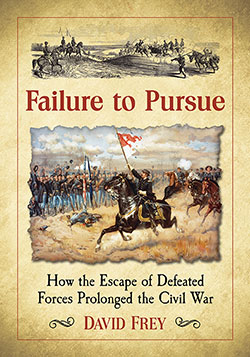Failure to Pursue
How the Escape of Defeated Forces Prolonged the Civil War
$39.95
In stock
About the Book
Was the Civil War preordained to last four years or were there reasons why neither side could land a knockout punch? From the outset, both North and South had anticipated a brief conflict but despite more than 50 bloody battles neither could force a decisive conclusion. For most of the war, these battles followed a pattern: the victors claimed the field and the vanquished retreated to rest, resupply and fight another day.
Some generals began to realize that pursuit to capture or destroy the retreating enemy was needed to end the war—not an easy task. Taking a fresh look at the tactics that characterized many major combat actions in the war, this book examines the performance of unsuccessful (sometimes insubordinate) commanders and credits two generals with eventually seeing the need for organized pursuit.
About the Author(s)
Bibliographic Details
David Frey
Format: softcover (7 x 10)
Pages: 412
Bibliographic Info: notes, bibliography, index
Copyright Date: 2016
pISBN: 978-1-4766-6669-3
eISBN: 978-1-4766-2713-7
Imprint: McFarland
Table of Contents
Table of Contents
Acknowledgments v
Introduction 1
Western Theater
1. Overview—Antebellum Influences 7
2. Grant at Shiloh—April 6–7, 1862 17
3. Buell vs. Bragg in Kentucky—1862 27
4. Iuka and Corinth II—September and October 1862 43
5. Rosecrans Replaces Buell—October 1862–October 1863 57
6. Turnaround at Chattanooga—October and November 1863 82
7. Sherman’s Atlanta Campaign—1864 92
8. Thomas After Nashville—December 1864 120
Eastern Theater
9. First Bull Run—July 21, 1861 149
10. Stonewall in the Valley—Spring 1862 156
11. Lee’s Pursuit of Seven Days—June 25–July 1, 1862 173
12. Second Bull Run—August 29–30, 1862 196
13. Chantilly, a.k.a. Ox Hill—September 1, 1862 209
14. McClellan After Antietam—September–October 1862 218
15. Eastern Horse Soldiers 236
16. Gathering at Getttysburg—June–July 1863 250
17. Lee and Meade After Gettysburg—July 4–14, 1863 271
18. Little Phil Comes East—1864 300
19. Grant’s Ultimate Pursuit—April 1865 328
20. Conclusions 348
Chapter Notes 359
Bibliography 393
Index 397
Book Reviews & Awards
“thought-provoking and well-organized. The author has done a lot of reading and knows his material. Even old buffs are likely to find fresh viewpoints and anecdotal nuggets they didn’t know”—America’s Civil War.





